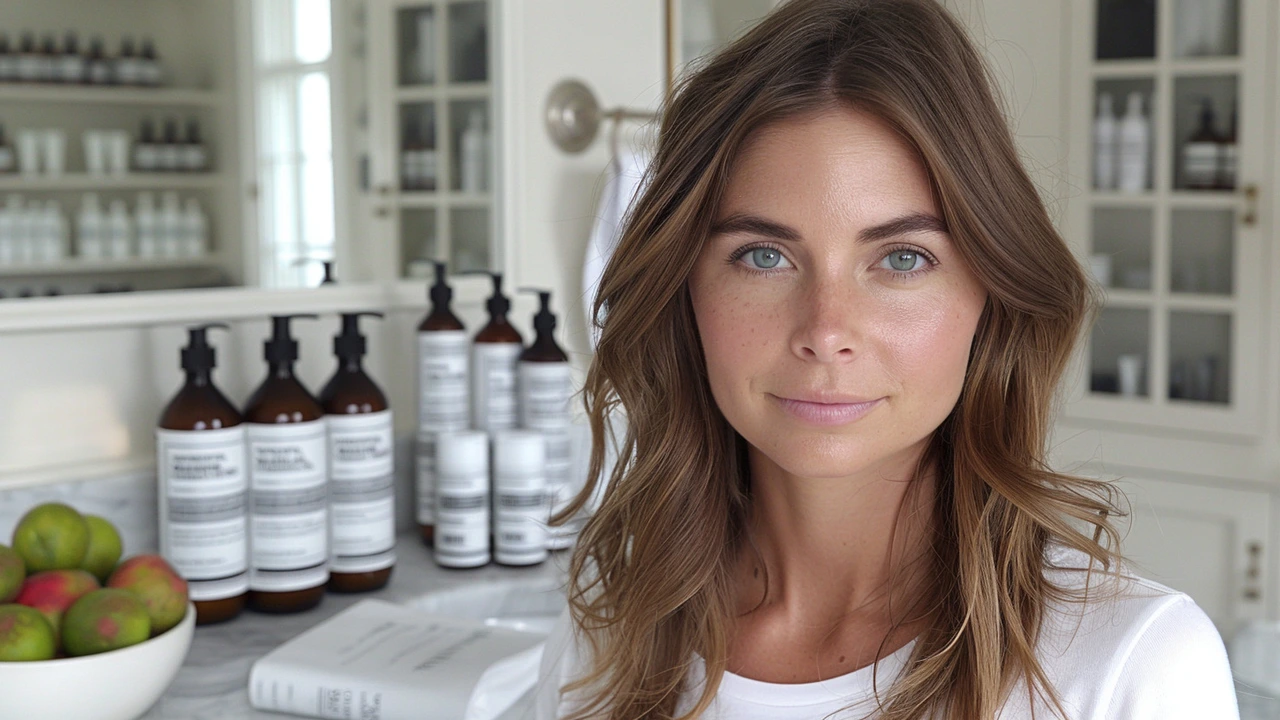When it comes to skin health, fungal discoloration is an issue that can affect anyone. This article dives into creating an effective skincare routine aimed at preventing these unwanted spots. Understanding the roots of the problem and implementing preventive measures can keep your skin healthy and looking its best.
Fungal skin discoloration can occur when an overgrowth of yeast or fungi disrupts the natural balance of your skin. The result can be discolored patches that may make you self-conscious. However, with the right skincare routine, you can minimize the risk.
A good daily cleansing routine, proper exfoliation, and maintaining a clean and balanced diet are key aspects of preventing fungal discoloration. Including antifungal products in your routine can add an extra layer of protection.
By paying attention to your skin’s needs and making thoughtful adjustments to your grooming habits, you can keep fungal discoloration at bay and enjoy clearer, healthier skin.
- Understanding Fungal Skin Discoloration
- Daily Cleansing Routine
- Exfoliation and Hydration
- Diet, Lifestyle, and Antifungal Products
Understanding Fungal Skin Discoloration
Fungal skin discoloration is a condition that arises when there is an overgrowth of fungi on the skin. This can result in patches that are either lighter or darker than the surrounding skin. One of the most common causes is a yeast called Malassezia, which naturally lives on the skin but can multiply excessively due to various factors, such as humidity, heat, or an oily complexion.
These patches, which can appear on the chest, back, neck, and arms, might be dry and scaly. While not usually itchy or painful, they can cause a significant amount of distress due to their appearance. It’s important to note that fungal skin discoloration is not contagious and anyone can develop it, although it tends to be more common in adolescents and young adults. Dermatologists often see an uptick in cases during the summer months, when heat and sweat create a favorable environment for fungal growth.
Common Triggers
Several factors can contribute to the overgrowth of fungi. Warm and humid climates are known culprits, making tropical and sub-tropical regions hot spots for fungal skin issues. Wearing tight or non-breathable clothing can also trap moisture and heat, boosting fungal growth. People with oily skin are at a greater risk since oil can provide a breeding ground for fungi. Additionally, hormonal changes can influence the balance of fungi on the skin. For instance, the fluctuations during adolescence or pregnancy may trigger an increase in fungal activity.
"Proper hygiene and appropriate clothing choices can play a significant role in keeping fungal skin discoloration at bay," says Dr. Emily Keating, a well-known dermatologist.
Diagnosis and Treatment
Dermatologists typically diagnose fungal skin discoloration through a visual examination and may confirm it with a Wood's lamp test or skin scraping. The goal of treatment is to rebalance the skin's fungal population. Topical antifungal creams and shampoos often prove effective. These products usually contain active ingredients such as ketoconazole or selenium sulfide, which target the fungi causing the discoloration.
In some cases, especially when the discoloration covers large areas or has been present for a long time, oral antifungal medications might be prescribed. It’s essential to follow the prescribed treatment regimen strictly, as incomplete treatment can lead to recurrence.
Preventing future outbreaks relies on maintaining good skin hygiene and being mindful of environmental factors that contribute to fungal growth. Regular cleansing with an antifungal soap can be helpful. Staying cool and dry, particularly in hot and humid conditions, and opting for loose, breathable clothing can also make a significant difference in preventing fungal skin discoloration.
Daily Cleansing Routine
A well-thought-out daily cleansing routine is your first line of defense against fungal skin discoloration. Dirt, sweat, and oils can accumulate on your skin throughout the day, providing a breeding ground for fungi. By cleansing your skin effectively, you remove these impurities and keep your skin’s natural balance intact.
Start by selecting a gentle cleanser that suits your skin type. Harsh soaps can strip away natural oils, leaving your skin dry and vulnerable to infections. Look for a pH-balanced cleanser with natural ingredients like tea tree oil, which is known for its antifungal properties. Cleansing twice a day is optimal—in the morning to remove any oil build-up overnight and at night to wash away the grime collected during the day.
Water temperature is an often-overlooked detail but can significantly affect your skin’s health. Hot water might feel satisfying, but it can strip away essential oils, while cold water may not effectively remove impurities. Lukewarm water is the sweet spot, helping to gently cleanse while maintaining the natural barrier of your skin.
Applying your cleanser in gentle, circular motions can improve blood circulation and ensure an even application. Pay attention to areas prone to oiliness, such as the T-zone (forehead and nose) but don’t neglect other areas which might not be as greasy.
Once you’ve finished cleansing, it’s crucial to pat your skin dry with a soft towel rather than rubbing, which can cause irritation. This step might seem minor, but it prevents micro-abrasions that can lead to infections. Additionally, damp skin can be more susceptible to fungal growth, so make sure your skin is thoroughly dry.
Moisturizing After Cleansing
Always follow up your cleansing routine with a moisturizer that suits your skin type. Moisturizing is essential as it helps retain your skin's hydration, creating a stronger barrier against external irritants, including fungi. Choose a non-comedogenic moisturizer that won't clog your pores. Ingredients like hyaluronic acid are great for maintaining moisture without adding excess oil.
Dr. Rachel Nazarian from the Schweiger Dermatology Group states, “A proper cleansing routine not only helps in removing dirt and oil but also maintains the integrity of the skin barrier, which is essential in preventing infections and discoloration.”
Additional Tips for Daily Cleansing
While a twice-daily cleansing routine forms the foundation, there's more you can do to maintain optimal skin health. Regularly changing your pillowcases and towels can prevent the build-up of fungi and bacteria. Limit the use of heavy makeup, as it can clog pores and create an environment conducive to fungal growth.
- Wipe down your phone screen periodically to keep it free from oils and dirt, which can transfer to your face.
- Avoid touching your face throughout the day to prevent the spread of bacteria and fungi from your hands.
- Incorporate a gentle exfoliant into your routine a few times a week to remove dead skin cells that can harbor fungi.
Incorporating these steps into your daily routine can significantly reduce the risk of fungal skin discoloration. Regular cleansing, moisturizing, and adopting mindful habits will ensure your skin remains healthy and vibrant.
Exfoliation and Hydration
Exfoliation is a crucial step in any effective skincare routine, especially when aiming to prevent fungal discoloration. By removing buildup of dead skin cells, exfoliation helps maintain clear pores and a healthy skin barrier. Use a gentle exfoliant that won't irritate your skin. Physical exfoliants like scrubs and brushes can be effective, but remember to avoid over-scrubbing to reduce the risk of micro-tears.
Chemical exfoliants—such as those containing alpha hydroxy acids (AHAs) or beta hydroxy acids (BHAs)—are also good options. These acids help dissolve dead skin cells, allowing for easier removal and promoting a smoother skin texture. Dermatologists often recommend incorporating these products slowly into your routine, starting with one or two times a week and increasing as your skin builds tolerance.
On the hydration front, keeping your skin moisturized forms a protective barrier that inhibits fungi growth. Skin that is well-hydrated is less likely to experience excessive dryness or oiliness, creating a more balanced environment. Choose moisturizers that are non-comedogenic to avoid clogging pores. Ingredients like hyaluronic acid or glycerin are wonderful for drawing moisture into the skin, making them excellent for dry to normal skin types.
Proper hydration isn't just about what you apply on your skin; it also involves your diet. Drinking ample amounts of water each day ensures your skin remains hydrated from the inside out. Eating hydrating foods like cucumbers, oranges, and strawberries not only helps keep your skin plump but also provides essential nutrients for overall skin health. Lauryn Evarts Bosstick, founder of The Skinny Confidential, often speaks on her platform about the importance of good hydration, saying,
"Staying hydrated is one of the simplest yet most important things you can do for your skin. It's your body's way of keeping everything functioning properly."
Consider incorporating a humidifier into your living space, especially during dry winter months. The extra moisture in the air can help keep your skin from drying out and provide a conducive environment for maintaining skin health. Pairing hydration strategies with regular exfoliation can significantly reduce the likelihood of fungal infections and discoloration.
DIY Exfoliation and Hydration Tips
If you prefer more natural or DIY approaches, there are several effective options. A simple homemade scrub made with sugar and coconut oil can serve as a gentle physical exfoliant. For a chemical exfoliant, try a mask made from yogurt and honey; the lactic acid in the yogurt acts as a natural exfoliant, while honey provides soothing and hydrating properties.
When it comes to hydration, a homemade facial mist combining rose water and a few drops of glycerin can act as a quick, refreshing hydrator throughout the day. Apply your moisturizer immediately after washing your face, while your skin is still damp, to lock in the most moisture. These small steps, practiced consistently, contribute significantly to keeping fungal issues and discoloration at bay.
Diet, Lifestyle, and Antifungal Products
Your diet and lifestyle play a vital role in the health of your skin. A balanced diet rich in vitamins and minerals can boost your immune system and help prevent fungal infections. Incorporating more fruits, vegetables, lean proteins, and whole grains into your diet provides the nutrients your skin needs to stay healthy. Sugar, dairy, and processed foods can promote fungal growth, so it's wise to limit these items. Drinking plenty of water ensures your skin stays hydrated, reducing the risk of fungal infections.
Regular exercise is equally important. Not only does it improve circulation, but it also helps to manage stress – a known factor in various skin conditions. Sweating during a workout can aid in expelling toxins from your body, contributing to healthier skin. However, it is crucial to shower and change into clean clothes immediately after exercising to prevent fungal growth caused by damp, sweaty attire.
Implementing good hygiene practices is another vital aspect of preventing fungal skin discoloration. This includes regular bathing, keeping skin dry, and wearing loose-fitting, breathable fabrics. Cotton and moisture-wicking materials are excellent choices as they allow your skin to breathe and minimize sweat accumulation, which can create a breeding ground for fungi.
When it comes to antifungal products, choosing the right ones can make all the difference. Over-the-counter antifungal creams, powders, and sprays can be very effective. Products containing ingredients like clotrimazole, miconazole, or terbinafine are known for their antifungal properties. Applying these products as directed can help manage and prevent fungal infections. It's always a good idea to consult with a dermatologist to get recommendations tailored to your specific needs.
According to the American Academy of Dermatology, "Fungal infections are common in warm, moist environments. Keeping the skin clean and dry and using the right antifungal treatment can greatly reduce the risk of recurring infections."
Besides using topical antifungal treatments, incorporating antifungal dietary supplements can boost your overall defense against fungal infections. Probiotics, like yogurt and kombucha, can help maintain your skin's natural flora, keeping harmful fungi in check. Garlic, known for its antifungal properties, can easily be added to your diet to aid in preventing infections.







TRICIA TUCKER
May 13, 2024 AT 13:33